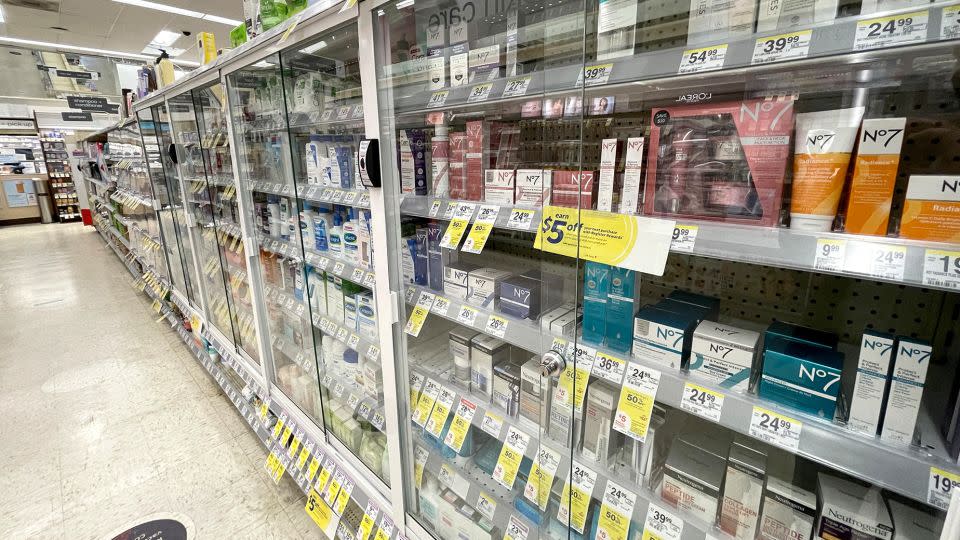Opinion: Retail chains are closing stores. There are better ways to deal with shoplifting
Editor’s Note: Keldy Ortiz is a New York-based writer who focuses on issues of race, community affairs and social justice.The views expressed here are his own. Read more opinion at CNN.
Two things can be true at the same time. Businesses say an epidemic of shoplifting is roiling the retail industry, leading them to make tough decisions about the need to close stores in some communities to stem losses.

But what’s also true, is that the communities where businesses are closing down stores are often left feeling bereft and abandoned once the establishments are gone. The loss of a major store can be a massive inconvenience — even a hardship — for communities where there are precious few shopping options.
That’s certainly the case for East Harlem, a community that is home to about 125,000 people and a bustling neighborhood with good transportation, vibrant street art and a multitude of people speaking myriad languages. What the community does not have is a vast array of shopping options.
The neighborhood was once bristling with bodegas and corner convenience stores. There are still some but — as is the case for many urban communities across the country — big chain stores have supplanted some mom-and-pop establishments. A lot of bodegas shut down during the Covid-19 pandemic. Other small retailers have closed amid the rising popularity of online shopping.
Residents of the predominantly Latino and Black neighborhood increasingly have come to rely upon national retail chains for many essentials — including groceries. That’s why the impending closure of East Harlem’s Target store is such a loss.
Its announcement a few weeks back that it would close a number of outlets in urban areas on October 21 has drawn a lot of attention to Target, a company that has a net worth of nearly $50 billion. The company says it stands to lose a half a billion dollars this year because of theft.
Target’s CEO Brian Cornell told analysts in August that the thefts are “unacceptable.” The following month, the company announced that it would close nine stores across four states — including the store in East Harlem. The other affected stores, also in major urban centers, include Seattle, Portland, San Francisco and Oakland.
In a statement, Target said, “Before making this decision, we invested heavily in strategies to prevent and stop theft and organized retail crime in our stores, such as adding more security team members, using third-party guard services, and implementing theft-deterrent tools across our business.”
Target is, in fact, just one of many retailers saying they have no choice but to close outlets because of losses resulting from shoplifting. Walmart cited similar reasons for its decision to close stores in Portland and Chicago. And Walgreens recently announced the closure of five San Francisco area stores. The list goes on and on.
But as CNN reported recently, the retail industry’s own numbers on losses caused by theft cast doubt on their claim that the problem of “shrink” as it’s called in the industry, is worsening. It seems that retailers may be blaming theft for losses when they don’t actually know the cause. As Walgreens’ finance chief James Kehoe said during an earnings call earlier this year, “maybe we cried too much” about merchandise losses.
And the nation’s largest retail trade group — the National Retail Federation — found in its annual survey of some 60 retailers that the average shrink rate as a percentage of sales dropped to 1.4% in 2021 from 1.6% in 2020 — a figure that has held fairly steady at about 1.4% for the past decade.

Meanwhile, the ones who are hurt most by closures are customers in many urban communities who suddenly find they have nowhere to shop. A former council member in Oakland, California told a local television station that their area’s Target — one of the stores that the corporation has decided to close — had been the first major retailer to arrive in the neighborhood in decades.
“Target was a big fish for us. It was the first major retail downtown in 30 years,” former council member Lynette Gibson McElhaney said. “We now lost the CVS in Target which is where people were being directed.”
In East Harlem, it’s not just shoppers lamenting Target’s departure later this month. Owners of nearby businesses say they’ll miss the foot traffic generated by people frequenting the store.
“Any major employer like that leaving — 200 jobs I think it is? — that’s a big hit for the neighborhood. There’s not a lot of businesses in that neighborhood,” Lou Martins, one of the owners of an area restaurant, Bistro Casa Azul, said in an interview with the local Fox News station.
Opening an establishment in a neighborhood is more than a business decision: It’s also a promise, a pact suggesting a good faith effort to aim for longevity and long term community investment — not just a financial one.
Target arrived in the Manhattan neighborhood of East Harlem, which sometimes is called Spanish Harlem, and sometimes “El Barrio”— “the neighborhood” in Spanish — in 2010. It has been the place where consumers could purchase everything from bath towels and toothbrushes to greeting cards and Christmas ornaments.
And for East Harlem residents, the retail store is also a much-needed purveyor of quality, healthy food and other necessities close to home, reducing the need to travel by bus or subway to stores outside of the neighborhood for their food shopping.
In some places where big box stores are not closing, there is another significant and unwelcome development: Companies including some Target outlets, CVS stores, Rite Aids and other establishments have shuttered away toiletries, laundry detergent and a raft of other products in glass cases, behind lock and key, making them accessible only by request to a store clerk. This is a slight to the customers who want to be able to quickly and easily pick up toothpaste or shampoo, each of whom is essentially treated as if they’re a potential shoplifter.
It’s all part of a bigger conversation about our changing urban centers, development and what we owe the communities where this growth and change occurs. Whatever the cause and whatever the scope of the problem, something has to be done to address retail losses caused by crime.
But there must be a better solution than pulling up stakes and fleeing communities in need. One thing they could do is focus their efforts on organized crime gangs that fence stolen merchandise online.
There are efforts underway to ramp up such efforts. Last year, Congress passed the INFORM Act, requiring digital marketplaces such as Amazon, eBay and even smaller retailers to disclose the identity of high-volume online sellers. The goal is to give law enforcement another tool to apprehend people who steal large quantities of goods and resell them online.
Another federal bill that might make a difference if it becomes law is the Combating Organized Retail Crime Act, which would, among other measures, establish a multi-agency bureau to investigate retail crime. The agency would compile data at the federal and state level on organized crime rings that prey on retailers. And, it would stiffen penalties on those found guilty of committing multiple acts of theft by aggregating the dollar amounts of the items stolen. After a specific dollar amount is reached, the offender could be charged with a felony.
At the local level, in my city of New York, Mayor Eric Adams earlier this year announced measures to help stem the impact of organized thefts in retail outlets — a program which, like the INFORM Act and the Combating Organized Retail Crime Act, targets repeat offenders and organized rings. That will help business owners keep their merchandise on their shelves, rather than feeling that they have to close up shop.
The problem of retail crime is bigger than any mom-and-pop store — or even any national chain store — can solve by posting a security guard at the door. Some of the initiatives being introduced give me hope that the members of crime syndicates responsible for the thefts will be brought to justice.
If they are, the stores in these communities will feel like safer places to operate, and that will encourage business to remain the vital resource they are for people who shop there.
For more CNN news and newsletters create an account at CNN.com

